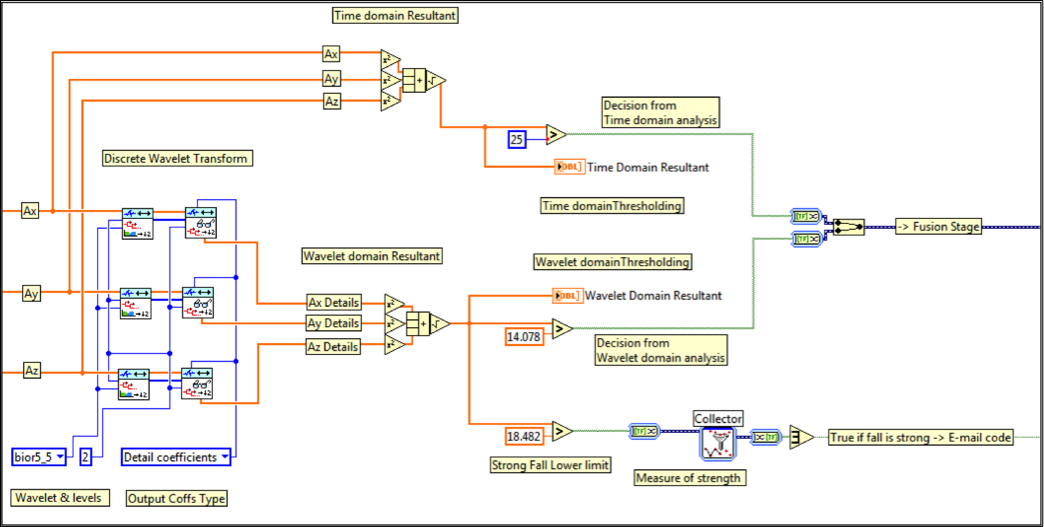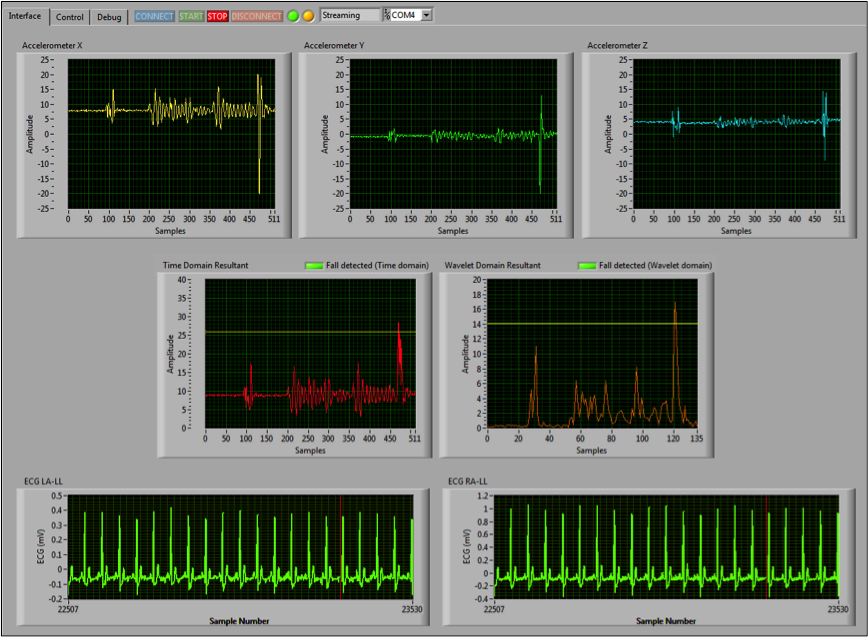- Document History
- Subscribe to RSS Feed
- Mark as New
- Mark as Read
- Bookmark
- Subscribe
- Printer Friendly Page
- Report to a Moderator
- Subscribe to RSS Feed
- Mark as New
- Mark as Read
- Bookmark
- Subscribe
- Printer Friendly Page
- Report to a Moderator
Fall Detection using Shimmer Technology and Multiresolution Analysis
Contact Information
University: Qatar University
Team Members (with year of graduation): Abdallah Daoud (2013), Abdallah Fard (2013) and Wesam El-Refaei (2013)
Faculty Advisers: Dr. Abbes Amira and Dr. Fadi Jaber
Email Address: Abdallah.m.daoud@gmail.com, Abbes.Amira@uws.ac.uk, fjaber@qu.edu.qa
Submission Language: English
Project Information
Title:
Fall Detection Using Shimmer Technology and Multiresolution Analysis
Description:
The project aims at developing a real-time, robust and intelligent fall detection system using Wavelet based multiresolution analysis in order to detect human falls and their strength. The system can be deployed for remote monitoring of elderly people at home.
Products:
- NI LabVIEW 2012
- NI Advanced signals processing toolkit
- Microsoft Outlook
- Shimmer platform
The Challenge:
The system should be able to detect falls and distinguish between falls and activities of daily living (ADL), which is a great challenge that requires a time-frequency processing method, a database featuring different daily living scenarios and an optimum Thresholding method. Another challenge is to determine the strength of the fall, which can be measured using multiresolution analysis on the acquired acceleration signals. An intelligent alerting system is also integrated into the proposed system to send messages to the doctor, nurse or relative upon the detection of the fall.
The Solution:
The proposed system in our project consists of a fall detection system of three stages, signals acquisition, signal processing, fusion and the alerting stage. The flowchart of the proposed system is shown in Figure 1.

Figure 1 – System flowchart
The first stage consists of the acquisition of the Acceleration signals in the three axes (x-axis, y-axis and z-axis), from a Shimmer platform, which features an integrated 3-axial accelerometer. The diagram of the Shimmer platform is shown in Figure 2. The platform is worn on the chest area using an accessory strap. The signals are sent in real time to a computer running LabVIEW, using Bluetooth technology.

Figure 2 - Shimmer diagram
Shimmer Research provides an Instrument Drive Library (IDL) that contains tools and SubVIs that can assist the user to develop useful Shimmer LabVIEW applications. The main VI used in our system is “Shimmer.vi”, which offers full control of the shimmer including sensor related settings and connectivity. The VI acts as a three-state machine as shown in Figure 3.

Figure 3 - Shimmer.vi as a three-state machine
The second stage is the signal analysis stage, which happens in LabVIEW by applying both time domain analysis and wavelet analysis simultaneously on the acquired acceleration signals. The detail coefficients are generated using Discrete Wavelet Transform (DWT) by applying Biorthogonal 5-5 with two levels of decomposition on the acceleration signals and then plugging the coefficients in the resultant acceleration formula (in real time), as in Eq. 1.

where d represents the detail coefficients, Ax, Ay and Az are the acceleration signals in the x-axis, y-axis and z-axis directions, respectively. The values are then compared to a predefined threshold in order to make a decision on whether a fall has happened or not. The values are also compared to another threshold level for the purpose of measuring the strength of the fall. Mathematical metrics were applied on the database acceleration signals in order to reach the appropriate threshold levels. The time domain analysis consists of applying the Resultant acceleration formula on the raw acceleration signals acquired from the platform and then comparing them to a predefined threshold value), as in Eq. 2.

National Instruments provides the Advanced Signal Processing toolkit, which was used to implement the discrete wavelet transform in the proposed fall detection system. The code responsible for this is shown in Figure 4.

Figure 4 - Signal Processing LabVIEW code
Figure 5 shows the fall and ADL scenarios with signals of the resultant acceleration in both time domain and wavelet domain using Biorthogonal (5-5) wavelet with two levels of decomposition.

Figure 5 - Resultant acceleration signals in time domain and wavelet domain [bior5-5 L2] for different scenarios
The third stage is the fusion stage, which consists of making use of both analysis methods (time domain and wavelet domain) in order to make a final decision on the status of the person. A logic AND function was applied in the code in order to fuse the two methods. This process was found to assist in increasing the overall system performance.
The final stage is the intelligent alerting stage. This stage features a down counter, which starts when a fall has been detected. The user has the choice to abort the alerting process in case they have recovered from the fall within 20 seconds, otherwise, an automatic alerting message is sent. Figure 6 shows the message displayed when a fall is detected.

Figure 6 – User-controlled alert
An alerting E-mail is sent to the authorized person when a fall has been detected. The E-mail includes information about the strength of the fall and the priority of the E-mail is set based on that piece of information. The alerting E-mail is shown in Figure 7.

Figure 7 – Alerting E-mail
A file that includes information about the condition of the person, which includes [Real time, Ax, Ay, Az, Time domain resultant detail coefficients, Wavelet resultant, ECG Right Arm (RA) and ECG Left Arm (LA)]. Figure 8 shows the delivered log file.

Figure 8 - Data log spreadsheet
National Instruments LabVIEW software is a great tool that can be used for many real-life applications in different fields, such as the field of biomedical applications. Shimmer Research provides all the tools needed for the connection and signal acquisition from Shimmer to LabVIEW. The advanced signal processing toolkit includes many software tools and utilities for time-frequency analysis and wavelets. The Discrete Wavelet Transform (DWT) was conveniently applied on the acceleration signals in real time. The user interface of the system running in LabVIEW is shown in Figure 9. The acceleration signals, time domain resultant, wavelet resultant and ECG waveforms are displayed in real time.

Figure 9 - System User Interface
The system is fully functional and is able to distinguish between falls and Activities of Daily Living (ADL) with an overall accuracy of 93%. The project was accomplished within two courses at Qatar University as a graduation project, ending up with about 7 months of work.
The video demonstration of the proposed fall detection system can be viewed below:
The fall detection system can be improved by making use of the available Shimmer expansion ECG module, which is able to generate ECG data that can be integrated for the purpose of improving the accuracy of the system. Separate Thresholding profiles could be created based on the user’s level of activity. A larger database that includes people of different ages and builds could be used to increase the accuracy of the process of fall detection.
More information about the project can be found at: www.detectafall.com
